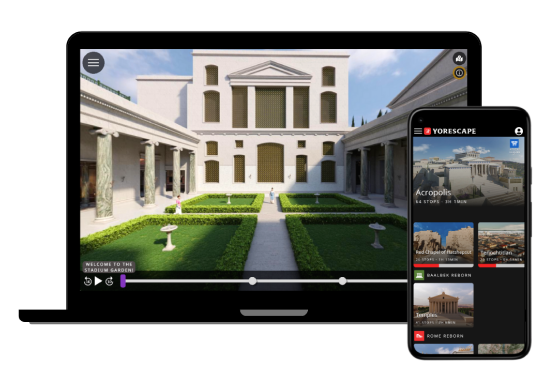
- Description
- Languages
- Credits
- Bibliography
Flyover Zone takes you on a virtual tour of one of the most iconic buildings in Rome: the Pantheon, still the largest unreinforced concrete dome in the world even after 1900 years. The virtual reconstruction at the heart of the tour is based on the latest archaeological excavations and research. The tour recounts the Pantheon's history and ancient urban setting and examines the principles of architecture, design, and engineering that have made it a source of inspiration for architects since the Renaissance. Your guide is Dr. Alberto Prieto, a Rome-based archaeologist and professional educator.
Audio: English
Subtitles: Arabic, Chinese, English, French, German, Italian, Spanish
Producer:
Bernard Frischer
Project Manager:
Alberto Prieto
Tour Guide/Narration:
Alberto Prieto
Scientific Advisors:
Amanda Claridge
Bernard Frischer
Paolo Liverani
C. Brian Rose
Russell Scott
Barry Strauss
Pier Luigi Tucci
Script:
Alberto Prieto
3D Modeling:
Lasha Tshkondia
Art Direction:
Mohamed Abdelaziz
Captions:
Juliette Bolloch (French)
Ambra Spinelli (Italian)
Nancy Peniche May (Spanish)
Hesham Hussein (Arabic)
Tiao-Guan Huang (Chinese)
Created By:
Flyover Zone
- L. Aliberti, M. Canciani, and M. A. Alonso-Rodríguez, “New Contributions on the Dome of the Pantheon in Rome: Comparison Between the Ideal Model and the Survey Model.” International Archives of the Photogrammetry, Remote Sensing and Spatial Information Sciences XL-5/W4 (2015) 291-297.
- M. T. Boatwright, Hadrian and the City of Rome. Princeton: Princeton University Press 1987.
- P. Broucke, “The First Pantheon: Architecture and Meaning,” in G. Grasshoff, M. Heinzelmann, and M. Wäfler (eds.), The Pantheon in Rome: Contributions to the Conference, Bern, November 9-12, 2006 (Bern Studies in the History and Philosophy of Science/Pantheon 1; Bern: Universität Bern 2009), 27-28.
- L. Chioffi, “Arcus Pietatis,” in E. M. Steinby, ed., Lexicon Topographicum Urbis Romae vol. I: A-C (Rome: Edizioni Quasar 1993), 102-103.
- P. Crucianelli, “I restauri al Pantheon dall'unità d'Italia al secondo dopoguerra.” Bullettino della Commissione Archeologica Comunale di Roma 108 (2007): 247-290.
- S. de Blaauw, “Das Pantheon als christlicher Tempel,“ in M. Jordan-Ruwe and U. Real (eds.), Bild- und Formensprache der spätantiken Kunst (Hugo Brandenburg zum 65. Geburtstag; Boreas/Münstersche Beiträge zur Archäologie vol. 17; Münster: Universität Münster 1994), 13-26.
- K. de Fine Licht, The Rotunda in Rome: A Study of Hadrian’s Pantheon. Copenhagen: Gyldendal 1968.
- R. A. Etlin, “The Pantheon in the Modern Age,” in T. A. Marder and M. Wilson Jones (eds.), The Pantheon: From Antiquity to the Present (New York: Cambridge University Press 2015), 380-422.
- R. Fletcher, “Geometric Proportions in Measured Plans of the Pantheon of Rome.” Nexus Network Journal 21 (2019): 329-345.
- P. Godfrey and D. Hemsoll, “The Pantheon: Temple or Rotunda?,” in A. King and M. Henig (eds.), Pagan Gods and Shrines of the Roman Empire (Oxford: Oxford University Press), 195-209.
- D. Gruber and G. Gruber, “Die Türe des Pantheon.“ Römische Mitteilungen 104 (1997): 3-74.
- A. Grüner, “Das Pantheon des Agrippa: Architektonische Form und urbaner Kontext,“ in G. Grasshoff, M. Heinzelmann, and M. Wäfler (eds.), The Pantheon in Rome: Contributions to the Conference, Bern, November 9-12, 2006 (Bern Studies in the History and Philosophy of Science/Pantheon 1; Bern: Universität Bern 2009), 41-67.
- L. Haselberger, “The Pantheon: Nagging Questions to No End,” in G. Grasshoff, M. Heinzelmann, and M. Wäfler (eds.), The Pantheon in Rome: Contributions to the Conference, Bern, November 9-12, 2006 (Bern Studies in the History and Philosophy of Science/Pantheon 1; Bern: Universität Bern 2009), 171-186.
- D. Heinzelmann, M. Heinzelmann, and W. Lorenz, “The Metal Roof Truss of the Pantheon’s Portico in Rome – 152 Tonnes of Bronze.” Construction History 33.2 (2018): 1-22.
- L. Hetland, “Dating the Pantheon.” Journal of Roman Archaeology 20 (2007): 95-112.
- L. C. Lancaster, “Materials and Construction of the Pantheon in Relation to the Developments in Vaulting in Antiquity,” in G. Grasshoff, M. Heinzelmann, and M. Wäfler (eds.), The Pantheon in Rome: Contributions to the Conference, Bern, November 9-12, 2006 (Bern Studies in the History and Philosophy of Science/Pantheon 1; Bern: Universität Bern 2009), 117-125.
- L. C. Lancaster, Concrete Vaulted Construction in Imperial Rome. Innovations in Context. Cambridge: Cambridge University Press 2005.
- L. Lancaster, G. Sottili, F. Marra, and G. Ventura, “Provenancing of Lightweight Volcanic Stones Used in Ancient Roman Concrete Vaulting: Evidence from Rome.” Archaeometry 53.4 (2011): 707–727.
- E. La Rocca, “Agrippa’s Pantheon and Its Origin,” in T. A. Marder and M. Wilson Jones (eds.), The Pantheon: From Antiquity to the Present (New York: Cambridge University Press 2015), 49-78.
- E. La Rocca, “Pantheon,” in E. M. Steinby, ed., Lexicon Topographicum Urbis Romae vol. V: T-Z (Rome: Edizioni Quasar 1999), 280-283.
- T. A. Marder, “The Pantheon in the Seventeenth Century,” in T. A. Marder and M. Wilson Jones (eds.), The Pantheon: From Antiquity to the Present (New York: Cambridge University Press 2015), 296-329.
- T. A. Marder, “The Pantheon After Antiquity,” in G. Grasshoff, M. Heinzelmann, and M. Wäfler (eds.), The Pantheon in Rome: Contributions to the Conference, Bern, November 9-12, 2006 (Bern Studies in the History and Philosophy of Science/Pantheon 1; Bern: Universität Bern 2009), 145-153.
- T. A. Marder and M. Wilson Jones, “Introduction,” in T. A. Marder and M. Wilson Jones (eds.), The Pantheon: From Antiquity to the Present (New York: Cambridge University Press 2015), 1-48.
- R. Mark and P. Hutchinson, “On the Structure of the Roman Pantheon.” Art Bulletin 68.1 (1986): 24-34.
- G. Martines, “The Conception and Construction of Drum and Dome,” in T. A. Marder and M. Wilson Jones (eds.), The Pantheon: From Antiquity to the Present (New York: Cambridge University Press 2015), 99-131.
- G. Martines, “The Structure of the Dome,” in G. Grasshoff, M. Heinzelmann, and M. Wäfler (eds.), The Pantheon in Rome: Contributions to the Conference, Bern, November 9-12, 2006 (Bern Studies in the History and Philosophy of Science/Pantheon 1; Bern: Universität Bern 2009), 98-105.
- W. Martini, “Das Pantheon Hadrians?,” in G. Grasshoff, M. Heinzelmann, and M. Wäfler (eds.), The Pantheon in Rome: Contributions to the Conference, Bern, November 9-12, 2006 (Bern Studies in the History and Philosophy of Science/Pantheon 1; Bern: Universität Bern 2009), 139-143.
- F. Masi, I. Stefanou, and P. Vannucci, “On the Origin of the Cracks in the Dome of the Pantheon in Rome.” Engineering Failure Analysis 92 (2018): 587-596.
- F. G. Moore, “The Gilt-Bronze Tiles of the Pantheon.” American Journal of Archaeology 3.1 (1899): 40-43.
- A. Nesselrath, “Impressions of the Pantheon in the Renaissance,” in T. A. Marder and M. Wilson Jones (eds.), The Pantheon: From Antiquity to the Present (New York: Cambridge University Press 2015), 255-295.
- L. Partridge, The Art of the Renaissance in Rome 1400-1600. Upper Saddle River, NJ: Prentice Hall 1996.
- S. Pasquali, “Neoclassical Remodeling and Reconception, 1700-1820,” in T. A. Marder and M. Wilson Jones (eds.), The Pantheon: From Antiquity to the Present (New York: Cambridge University Press 2015), 330-353.
- S. Pasquali, “L’attico del Pantheon. Nuovi documenti sui marmi e sulla controversa ricostruzione del 1757,” in G. Grasshoff, M. Heinzelmann, and M. Wäfler (eds.), The Pantheon in Rome: Contributions to the Conference, Bern, November 9-12, 2006 (Bern Studies in the History and Philosophy of Science/Pantheon 1; Bern: Universität Bern 2009), 157-170.
- S. B. Platner and T. Ashby, A Topographical Dictionary of Ancient Rome. London: Oxford University Press 1929.
- A. S. Reiterman, “Clamp-holes and Marble Veneers: The Pantheon’s Lost Original Facing.” Journal of Roman Archaeology 23 (2010): 395-412.
- L. Rice, “Pope Urban VIII and the Pantheon Portico,” in G. Grasshoff, M. Heinzelmann, and M. Wäfler (eds.), The Pantheon in Rome: Contributions to the Conference, Bern, November 9-12, 2006 (Bern Studies in the History and Philosophy of Science/Pantheon 1; Bern: Universität Bern 2009), 155-156.
- L. Rice, “Bernini and the Pantheon Bronze.” In G. Satzinger and S. Schütze (eds.), Sonderdruck aus Sankt Peter in Rom 1506-2006 (Beiträge der internationalen Tagung vom 22.-25. Februar 2006 in Bonn; Munich: Hirmer 2008), 337-352.
- M. Scherer, “A Sustainable Geodetic Network for Documenting and Monitoring the Pantheon,” in G. Grasshoff, M. Heinzelmann, and M. Wäfler (eds.), The Pantheon in Rome: Contributions to the Conference, Bern, November 9-12, 2006 (Bern Studies in the History and Philosophy of Science/Pantheon 1; Bern: Universität Bern 2009), 215-222.
- R. Taylor, Roman Builders: A Study in Architectural Process. Cambridge: Cambridge University Press 2003.
- R. Taylor, “A Literary and Structural Analysis of the First Dome on Justinian's Hagia Sophia, Constantinople.” Journal of the Society of Architectural Historians 55.1 (1996): 66-78.
- N. Theocaris, “How the Bern Digital Pantheon Model Can Help Answer ‘Nagging Questions’ about the Pantheon,” in G. Grasshoff, M. Heinzelmann, and M. Wäfler (eds.), The Pantheon in Rome: Contributions to the Conference, Bern, November 9-12, 2006 (Bern Studies in the History and Philosophy of Science/Pantheon 1; Bern: Universität Bern 2009), 187-193.
- E. Thomas, “The Cult Statues of the Pantheon.” Journal of Roman Studies 107 (2017): 146-212.
- E. Thunø, “The Pantheon in the Middle Ages,” in T. A. Marder and M. Wilson Jones (eds.), The Pantheon: From Antiquity to the Present (New York: Cambridge University Press 2015), 231-254.
- G. M. Valenti, “A Computing Model for the Pantheon’s Cupola: From the Discrete to the Continuous. The Ideal Continuous Model,” in G. Grasshoff, M. Heinzelmann, and M. Wäfler (eds.), The Pantheon in Rome: Contributions to the Conference, Bern, November 9-12, 2006 (Bern Studies in the History and Philosophy of Science/Pantheon 1; Bern: Universität Bern 2009), 223-231.
- P. Virgili, “Scavi in piazza della Rotonda e sulla fronte del Pantheon,” in G. Grasshoff, M. Heinzelmann, and M. Wäfler (eds.), The Pantheon in Rome: Contributions to the Conference, Bern, November 9-12, 2006 (Bern Studies in the History and Philosophy of Science/Pantheon 1; Bern: Universität Bern 2009), 200-214.
- P. Virgili, “Pantheon,” in E. M. Steinby, ed., Lexicon Topographicum Urbis Romae vol. V: T-Z (Rome: Edizioni Quasar 1999), 284-285.
- P. Virgili and P. Battistelli, “Indagini in piazza della Rotonda e sulla fronte del Pantheon.” Bullettino della Commissione Archeologica Comunale di Roma 100 (1999): 137-154.
- T. Vogel, “A Structural Evaluation of the Pantheon — Envisaged Tasks,” in G. Grasshoff, M. Heinzelmann, and M. Wäfler (eds.), The Pantheon in Rome: Contributions to the Conference, Bern, November 9-12, 2006 (Bern Studies in the History and Philosophy of Science/Pantheon 1; Bern: Universität Bern 2009), 233-241.
- G. Waddell, “Sources and Parallels for the Design and Construction of the Pantheon,” in T. A. Marder and M. Wilson Jones (eds.), The Pantheon: From Antiquity to the Present (New York: Cambridge University Press 2015), 132-159.
- R. B. Williams, “A Nineteenth-century Monument for the State,” in T. A. Marder and M. Wilson Jones (eds.), The Pantheon: From Antiquity to the Present (New York: Cambridge University Press 2015), 354-379.
- M. Wilson Jones, “Building on Adversity: The Pantheon and Problems with Its Construction,” in T. A. Marder and M. Wilson Jones (eds.), The Pantheon: From Antiquity to the Present (New York: Cambridge University Press 2015), 193-230.
- M. Wilson Jones, “Who Built the Pantheon?: Agrippa, Apollodorus, Hadrian and Trajan,” in T. Opper (ed.), Hadrian: Art, Politics and Economy (London: British Museum 2013), 31-49.
- M. Wilson Jones, “The Pantheon and the Phasing of Its Construction,” in G. Grasshoff, M. Heinzelmann, and M. Wäfler (eds.), The Pantheon in Rome: Contributions to the Conference, Bern, November 9-12, 2006 (Bern Studies in the History and Philosophy of Science/Pantheon 1; Bern: Universität Bern 2009), 68-87.
- M. Wilson Jones, Principles of Roman Architecture. New Haven: Yale University Press 2000.
- A. Ziolkowski, “What Did Agrippa’s Pantheon Look Like? New Answers to an Old Question,” in G. Grasshoff, M. Heinzelmann, and M. Wäfler (eds.), The Pantheon in Rome: Contributions to the Conference, Bern, November 9-12, 2006 (Bern Studies in the History and Philosophy of Science/Pantheon 1; Bern: Universität Bern 2009), 29-39.
- A. Ziolkowski, “Pantheon,” in E. M. Steinby, ed., Lexicon Topographicum Urbis Romae vol. IV: P-S (Rome: Edizioni Quasar 1999), 54-61.

Subscribe to our Newsletter
Receive updates and exclusive promotions from Flyover Zone







